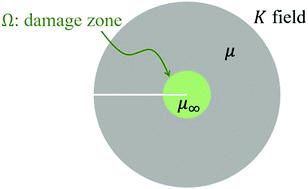当前位置:
X-MOL 学术
›
Soft Matter
›
论文详情
Our official English website, www.x-mol.net, welcomes your
feedback! (Note: you will need to create a separate account there.)
Time dependent fracture of soft materials: linear versus nonlinear viscoelasticity.
Soft Matter ( IF 2.9 ) Pub Date : 2020-06-08 , DOI: 10.1039/d0sm00097c Jingyi Guo 1 , Alan T Zehnder 1 , Costantino Creton 2 , Chung-Yuen Hui 3
Soft Matter ( IF 2.9 ) Pub Date : 2020-06-08 , DOI: 10.1039/d0sm00097c Jingyi Guo 1 , Alan T Zehnder 1 , Costantino Creton 2 , Chung-Yuen Hui 3
Affiliation

|
Toughness of soft materials such as elastomers and gels depends on their ability to dissipate energy and to reduce stress concentration at the crack tip. The primary energy dissipation mechanism is viscoelasticity. Most analyses and models of fracture are based on linear viscoelastic theory (LVT) where strains are assumed to be small and the relaxation mechanisms are independent of stress or strain history. A well-known paradox is that the size of the dissipative zone predicted by LVT is unrealistically small. Here we use a physically based nonlinear viscoelastic model to illustrate why the linear theory breaks down. Using this nonlinear model and analogs of crack problems, we give a plausible resolution to this paradox. In our model, viscoelasticity arises from the breaking and healing of physical cross-links in the polymer network. When the deformation is small, the kinetics of bond breaking and healing are independent of the strain/stress history and the model reduces to the standard linear theory. For large deformations, localized bond breaking damages the material near the crack tip, reducing stress concentration and dissipating energy at the same time. The damage zone size is a new length scale which depends on the strain required to accelerate bond breaking kinetics. These effects are illustrated by considering two cases with stress concentrations: the evolution of spherical damage in a viscoelastic body subjected to internal pressure, and a zero degree peel test.
中文翻译:

随时间变化的软材料断裂:线性与非线性粘弹性。
诸如弹性体和凝胶之类的软质材料的韧性取决于其耗散能量和降低裂纹尖端应力集中的能力。主要的能量耗散机制是粘弹性。断裂的大多数分析和模型都是基于线性粘弹性理论(LVT)的,其中假定应变很小,松弛机制与应力或应变历史无关。一个众所周知的悖论是,LVT预测的耗散区的大小不切实际地小。在这里,我们使用基于物理的非线性粘弹性模型来说明线性理论为何崩溃。使用这种非线性模型和类似的裂纹问题,我们为这种悖论提供了合理的解决方案。在我们的模型中,粘弹性来自聚合物网络中物理交联的断裂和愈合。当变形较小时,键断裂和恢复的动力学与应变/应力历史无关,并且该模型简化为标准线性理论。对于较大的变形,局部粘结破坏会破坏裂纹尖端附近的材料,同时降低应力集中并耗散能量。损伤区的大小是一个新的长度尺度,它取决于加速键断裂动力学所需的应变。通过考虑应力集中的两种情况,可以说明这些效果:受到内压的粘弹性体中球形损伤的演变以及零度剥离试验。局部粘结断裂会损坏裂纹尖端附近的材料,同时降低应力集中并耗散能量。损伤区的大小是一个新的长度尺度,它取决于加速键断裂动力学所需的应变。通过考虑应力集中的两种情况,可以说明这些效果:受到内压的粘弹性体中球形损伤的演变以及零度剥离试验。局部粘结断裂会损坏裂纹尖端附近的材料,同时降低应力集中并耗散能量。损伤区的大小是一个新的长度尺度,它取决于加速键断裂动力学所需的应变。通过考虑应力集中的两种情况,可以说明这些效果:受到内压的粘弹性体中球形损伤的演变以及零度剥离试验。
更新日期:2020-07-08
中文翻译:

随时间变化的软材料断裂:线性与非线性粘弹性。
诸如弹性体和凝胶之类的软质材料的韧性取决于其耗散能量和降低裂纹尖端应力集中的能力。主要的能量耗散机制是粘弹性。断裂的大多数分析和模型都是基于线性粘弹性理论(LVT)的,其中假定应变很小,松弛机制与应力或应变历史无关。一个众所周知的悖论是,LVT预测的耗散区的大小不切实际地小。在这里,我们使用基于物理的非线性粘弹性模型来说明线性理论为何崩溃。使用这种非线性模型和类似的裂纹问题,我们为这种悖论提供了合理的解决方案。在我们的模型中,粘弹性来自聚合物网络中物理交联的断裂和愈合。当变形较小时,键断裂和恢复的动力学与应变/应力历史无关,并且该模型简化为标准线性理论。对于较大的变形,局部粘结破坏会破坏裂纹尖端附近的材料,同时降低应力集中并耗散能量。损伤区的大小是一个新的长度尺度,它取决于加速键断裂动力学所需的应变。通过考虑应力集中的两种情况,可以说明这些效果:受到内压的粘弹性体中球形损伤的演变以及零度剥离试验。局部粘结断裂会损坏裂纹尖端附近的材料,同时降低应力集中并耗散能量。损伤区的大小是一个新的长度尺度,它取决于加速键断裂动力学所需的应变。通过考虑应力集中的两种情况,可以说明这些效果:受到内压的粘弹性体中球形损伤的演变以及零度剥离试验。局部粘结断裂会损坏裂纹尖端附近的材料,同时降低应力集中并耗散能量。损伤区的大小是一个新的长度尺度,它取决于加速键断裂动力学所需的应变。通过考虑应力集中的两种情况,可以说明这些效果:受到内压的粘弹性体中球形损伤的演变以及零度剥离试验。











































 京公网安备 11010802027423号
京公网安备 11010802027423号